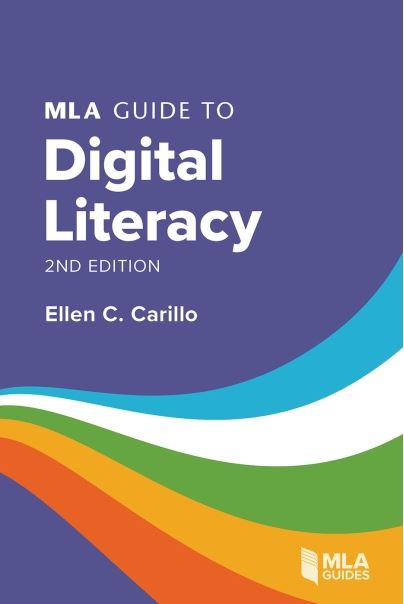Publication Details
| OLOR Series: | OLOR Reviews |
| Author(s): | Moira Connelly |
| Original Publication Date: | 15 July 2023 |
| Permalink: |
<gsole.org/olor/reviews/2023.07.15> |
Resource Overview
Media, Figures, Tables |
Resource Contents
Review of MLA Guide to Digital Literacy, 2nd ed.
In this short, readable guide, Ellen C. Carillo offers students tools to find, produce, and assess digital information. She also offers tools to instructors. At the end of each of the 11 chapters, Carillo provides activities appropriate for in-class group work, reflection paragraphs, discussion posts, or complete essays. The Appendix includes four complete lesson plans cross-referenced with sections of the chapters. Especially for instructors like me, who find that the curriculum of first-year writing is already asked to do too much, these resources would be a manageable way to incorporate teaching on digital literacy.
With my community college first-year writing students, I would begin this text with Chapter 3, “Understanding Online Searches,” and Chapter 4, “Conducting Online Research,” because they cover topics students might already be familiar with: understanding domain names and peer review, selecting key words, and narrowing searches. These chapters would be a good accompaniment to institution-specific library tutorials or in-class instruction by librarians, especially because librarians could introduce Boolean search strategies, which Carillo does not specifically cover. Chapter 4 introduces Google Scholar, inclusive research practices, the use of databases, and ways to assess a source’s relevance.
After giving students an opportunity to practice basic digital research, I would turn to Chapter 1, “What Is Digital Literacy,” and Chapter 2, “Understanding Filters and Algorithms, Bots, and Visual Manipulation.” These chapters contain important, but theoretical material. Chapter 1 defines digital literacy and outlines its scope. Carillo cautions students and instructors against relying on techniques, such as the CRAAP test—Currency, Relevance, Authority, Accuracy, and Purpose (Blakeslee, 2004)—that may no longer meet the complexity of today’s digital environment. Chapter 2 defines key concepts and provides a case study that demonstrates to students how digital behavior might exacerbate the human tendency to associate with like-minded others.
Chapters 5 through 7 help students gauge the credibility of digital information. In my first-year writing class, this material would apply to the modules on rhetorical analysis and writing a researched argument essay. Chapter 5, “Go to the (Primary) Source!,” urges students to rely on primary sources when possible; especially helpful is an extended example of two points of view on the same primary source. Carillo also includes in Chapter 5 strategies for evaluating visual sources, an increasingly important skill that may be unfamiliar to students. Chapter 6, “Surveying the Conversation by Reading Laterally,” suggests that students check trustworthiness of information by “reading laterally” (Wineburg and McGrew, 2017), a strategy that encourages students to read across the Internet to look for information to corroborate or discount a source. (Some material in Chapter 6 overlaps with material that Carillo and Horning (2022) present in their open access essay on the same topic.) Chapter 7, “Exploring the Credibility of Sources,” provides students with steps to examine the reliability of authors and publishers, as well as the bias of a source. In discussing source credibility, Carillo is careful to qualify the admonition that some instructors give students against using Wikipedia as a source. Carillo notes that Wikipedia can be a resource for students at the beginning of their research to gain an understanding of the scope of a topic or to find sources whose credibility would need to be checked. Carillo also explains to students the distinction between misinformation from disinformation, noting that disinformation is content spread with a negative intent, while misinformation is content spread in error.
The two final chapters are also particularly useful for students. Chapter 10, “Composing in Digital Spaces,” addresses composition across modes—linguistic, visual, aural, spatial, and gestural. This material might particularly interest students whose instructors ask them to present the same content in more than one genre. As Carillo notes that her chapter does not cover all the elements of multimedia composition, a complement to Carillo’s chapter might be Gagich’s (2020) open access essay that introduces students to multimedia assignments. Chapter 11, “Customizing Your Online Experience,” recommends several ways that students can navigate digital platforms to manage their online experience. For example, Carillo explains the concept of “clickbait” and recommends steps students can take to avoid being drawn in by it.
I was glad to see that Carillo gives credit to librarians, who have facilitated so much research on digital literacy and who now are on the front lines of discussions on digital literacy. At the end of the preface to instructors, Carillo notes, “Librarians have been pioneers in the teaching of information and digital literacy skills to students (and the public) . . . ” (p. 6). She says that instructors can rely on librarians for assistance beyond what her book provides. Similarly, I hope that our library colleagues can rely on us to show students respect for the work of librarians and our support for the goal of universal digital literacy.
References
Blakeslee, S. (2004). The CRAAP test. LOEX Quarterly, 31(3). Article 4. https://commons.emich.edu/loexquarterly/vol31/iss3/4
Carillo, E., & Horning, A. (2022). Effectively and efficiently reading the credibility of online sources. In D.L. Driscoll, M. Heise, M.K. Stewart, & and M. Vetter (Eds.), Writing Spaces: Readings on Writing, Volume 4 (pp. 35-50). Parlor Press. https://writingspaces.org/past-volumes/effectively-and-efficiently-reading-the-credibility-of-online-sources/
Gagich, M. (2020). An introduction to and strategies for multimodal composing. In D. Driscoll, M. Stewart, & M. Vetter (Eds.), Writing Spaces: Readings on Writing, Volume 3 (pp. 65-85). Parlor Press. https://writingspaces.org/past-volumes/an-introduction-to-and-strategies-for-multimodal-composing/
Wineburg, S., & McGrew, S. (2017). Lateral reading: Reading less and learning more when evaluating digital information. Stanford History Education Group Working Paper 2017-A1. SSRN, 9 Oct. 2017, papers.ssrn.com/sol3/papers.cfm?abstract_id=3048994.
 MLA Guide to Digital Literacy, 2nd ed.
MLA Guide to Digital Literacy, 2nd ed.
Ellen C. Carillo. 2022. Modern Language Association. [Paperback, $22.00; Ebooks, $16.99-$21.99].


